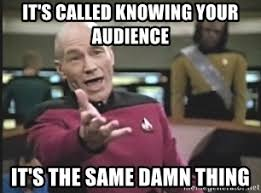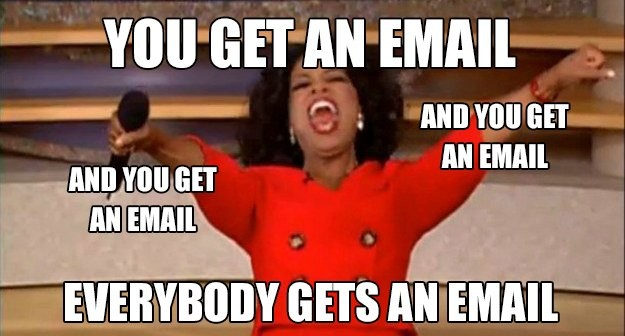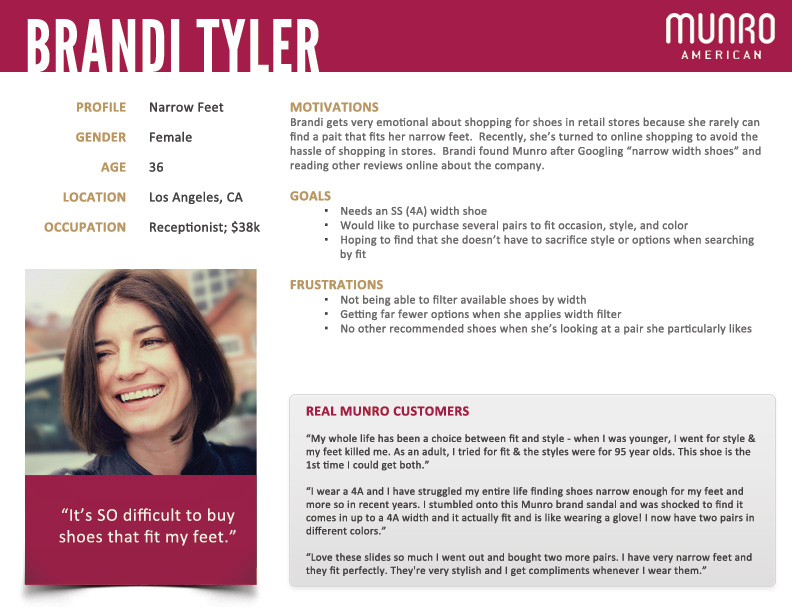We’ve all been there. It’s incredibly frustrating.
Half of the leads you’ve worked so hard to get into the funnel just aren’t the right people. They weren’t in the first place. So, how the heck did they become leads?
It’s one of the many catalysts that spark the age-old marketing vs. sales team feud.
“We’re getting heaps of leads, why aren’t you selling anything?”
“Because the leads are crap.”
You’ve heard it all before. Now, you want to do something about it.
Well, chances are if you’re getting the wrong leads at the top of your funnel, it's because your marketing efforts aren’t targeted correctly. Lead generation is all about targeting, and if you don’t have your buyer personas in check, then there’s just no way you can ever get your targeting right.
What Are Buyer Personas?
Buyer personas, sometimes called customer or marketing personas, are fictitious representations of potential customers. They are based on real data on your customers socio-demographics, buyer behaviour, user behaviour, interests, and company information.

You can view them as a generalized example of what your typical, or ideal customer looks like.
In the digital marketing world, buyer personas are a fundamental component of strategic planning, as they help us to direct our marketing messaging, tactics, and channels. They help us (marketers, salespeople, and support services alike) better understand our customers, attract new prospects, and form relationships with our customers as real humans.
Depending on the nature of your company, and the types of customers you have, your buyer personas may be quite simple or seriously complex. Often, you’ll have more than one buyer persona, especially if your company offers several products or services. In any case, buyer personas are typically made up of customers:
- Demographics
- Behaviours
- Interests
- Goals
- Motivations and influences
- Challenges
- Characteristics
Having a clear view of your typical customer(s) allows you to make informed decisions around product development, content creation, and outreach. Basically, anything you create that falls under the heading of ‘marketing’ should be directed by your buyer personas.
Why Is Creating Buyer Personas Important?
There are a number of massive benefits to creating buyer personas to support your marketing strategies and tactics, particularly in these three areas:
- Content Development
- Brand Engagement
- Email Marketing
Content Development

Content marketing is one of the fastest-growing marketing techniques in the world right now, and it’s little wonder why. People love consuming content. That goes for buyers in the B2B world as well as your typical consumer. Blogs, infographics, webinars, we’re obsessed with all of it.
The thing is though, everyone’s getting in on the game now. There are literally millions of new blog posts being published every day. So, how do you stand out from the crowd?
What you need to keep in the back of your mind is that you’re not trying to capture everyone with that latest piece of content. In fact, the pool of potential prospects you’re trying to impress is relatively small, when you compare them with the total amount of web traffic in any given month.
Having well-defined buyer personas, and then using them to guide your content creation, will help you to ensure your message is following the right path and finding the right people. This is vital. 63% of buyers think more positively of a company if the content they provide is interesting, relevant, and valuable.
This doesn’t mean you suddenly have to create two or three of every piece of content you have. In fact, many of your content assets will be able to be cross-purposed. If your primary and secondary personas are quite dissimilar though, it might be wise to make a few changes where relevant: imagery, tone of voice, asset type, and so on.
For example, at Roketto 2 of our personas include:
- Marketing Managers (persona A)
- Business Owners (persona B)
In our experience, we know that the majority of persona A prospects tend to be female and in a much younger age range than persona B, who tends to be male and in an older age range. Their interests are different, as are their roles in life, motivators, income range, influencers and so on. These are 2 very different types of people, and sending one marketing message and expecting it to resonate with both of these personas equally would be pretty much impossible.
Brand Engagement
Chances are your company is looking for long term customers, preferring them over once and done purchasers. If you really want to build long-lasting relationships such as these, then you need to get your customers engaging with your brand.
That goes beyond simply having them simply pay for your product or service and give you a little thumbs up. They need to be consuming your content on a regular basis, sharing it with their friends, family, and colleagues, and ideally, becoming an ambassador for your brand.
You need to find the right people for this though. If you’re selling to the wrong customers, then they aren’t going to really align with, and therefore engage with, your company. They just won’t believe in you. Nearly 9/10 consumers attest to the fact that personally relevant content has a positive influence on how they feel about your brand.
Makes sense right, give them something that’s relevant to them and they’re more likely to like you…
This is important for customer retention, but it’s even more important for attracting new prospects and generating leads. So important, in fact, that content that is based on well-research buyer personas improves customer engagement by up to 600%.
And, when you do see the leads start to pour in, you’ll be better able to prioritize them, as those that more closely match your buyer personas are more likely to turn into paying customers. As a result, you’ll see higher lead conversion rates, and a decent boost in ROI for your marketing efforts.
Email Marketing

If you’re finding your email marketing efforts are turning up less than desirable results, chances are it’s because they aren’t aligned with your buyer personas. I mean, would you engage with an email if it was personally relevant to you? No, right?
Remember when we said before that your company will likely have several different customer personas? That’s because people buy from you for different reasons. It doesn’t make sense then to send everyone the same email every month, buyers and prospects alike.
Your marketing personas will help you to refine the angle you take when writing email copy, and will also determine what you’re sharing. For example, that webinar you’re running might be great for Persona A, but not relevant at all for Persona B.
You might even go as far as using different email send times. For example, if one of your personas is a marketing manager, you might try and hit them with an email when they are sitting down for that 10 am coffee. If your other is a business owner though, you might schedule the send for 8 pm, when you know they’ve finished dinner, the kids are in bed, and they are clearing out the old inbox.
It’s about reaching the right people at the right time. And it can have a tremendous effect on your email marketing success rates. Basing your emails campaigns off of buyer personas can double your open rate, and boost your click-through rate fivefold.
Below you can see an example of how you might differentiate your email marketing strategy to target your personas separately.
| Email Marketing Tactic | Primary Persona | Secondary Persona |
|---|---|---|
| Tone | Serious, professional | Upbeat, casual |
| Send time | 10.30am | 7pm |
| Frequency | Monthly, long form | Twice a week, short form |
How To Develop Buyer Personas
Creating buyer personas can be a time-consuming task, but it’s also a fairly straightforward one. There are a few common pitfalls you should try and avoid, but if you follow this five-step process you’ll be sure one step closer to nailing your buyer personas and improving your marketing messaging:
- Talk To Your Team
- Evaluate Historical Data
- Interview Your Customers
- Collate The Results
- Create Documentation
For a more in depth step-by-step walk through, check out our full guide for creating marketing personas.
 Talk To Your Team
Talk To Your Team
A great place to start when creating buyer personas for marketing is to have a chat with the people who are talking to your customers every single day. Go and have a chat with your salespeople, and find out what they know about your common types of customers. Talk to your support team, they’ll have some pretty valuable insights into how your customers are using your product, and where they might be encountering issues. This can be a fantastic way to guide your future content creation.
 Evaluate Historical Data
Evaluate Historical Data
Jump into your sales CRM and pull out as much valuable information as you can. Focus on things like time to sale, typical purchase amount, etc.
If you’re a SaaS company, then client information on product usage will prove invaluable. What features are they using, and which are they not? When do they use them, and what for? This is a valuable insight as it gives you a look at how your customers are actually using your product, and the true value they are finding in it. You can then use that as the basis for your content creation and marketing messages.
 Interview Your Customers
Interview Your Customers
Nobody knows your customers better than your customers. Give them a call, or send them an email, and ask if they’d be interested in taking part in a survey.
Keep it short and sweet (you don’t want to take too much of their time), and focus on things like demographics, buyer behavior, goals, and challenges.
 Collate The Results
Collate The Results
Now it’s time to bring it all together. Retrieve the data from your customer surveys, and put this into numerical terms. You can aim to include any insights for your sales and support staff too.
Now that you’ve got some solid numerical data, it’s time to create some visuals. Use whatever works best for you: bar graphs, pie charts, it’s all fair game.
Use these findings to make some conclusions about your customers. For example, you might have found that 50% of your clients are in the 25-35 age bracket, with a further 30% in the 35-45 bracket. That’s an indication that you might have two main customer personas.
You’ll then want to try and align other findings with these results. For example, your buyers in the 35-45 age bracket probably have different income ranges and buyer behavior than do your 25-35 year old customers.
 Create Documentation
Create Documentation
Now it’s time to put it all together and share it with your colleagues. Buyer personas often look like fictional profiles, with a name, photo (stock image websites are great for this), and bio. You can then go deeper into categories such as challenges, goals, and behaviour.

 Common sub-headings for buyer persona documents include:
Common sub-headings for buyer persona documents include:
- Challenges
- Goals
- Needs
- Buyer behavior
- Common questions
- How we help
- Online activity
- User behavior
- Demographics
B2B Buyer Persona Examples
The best buyer personas are short and sweet. These aren’t meant to be 10-page essays that go into every little detail about your clients. Rather, marketing personas should be snapshots of your typical customer. They should be two pages at most, and easily digestible. Here are a few of our favorite examples of B2B buyer personas.

This is an example from Buffer, a social media tool for advertisers. This is a simple, one-page design that gives you all the information you need on one page. Note the Goals and Challenges box, which tells you a little about Fred’s common challenges, and, importantly, his biggest objections.

Another great example is this buyer persona from Munro American. This is a very specific customer profile for a retail shoe store. What we like about this one is the way that the profile includes a few quotes from actual Munro customers. This is a great way to make things real, especially if you’re going to be sharing these with your sales and marketing teams (and you should!)

You don’t have to get too heavy on the design front though. Above is a simple example from Referral Saasquatch. They’ve gone the extra mile on this one, including information such as common attitudes, motivators, and even internal influences. This is excellent information for your salespeople, as it gives them an insight as to how they might influence prospects, once you’ve got them into the funnel that is.
Buyer Persona Tools And Resources
By this point you’re probably thinking, “but where am I going to find the time for all this?”
If you don’t have time to learn something new, you can hire an expert to do it, and we’d be happy to give you a hand if that’s you.
Or, if you’d like to learn and give it a go yourself, check out our step by step blog post on how to create customer personas.
The good news is that there are many tools and processes out there that you can take advantage of, so you don’t need to start from scratch.
Automate Your Data Gathering
A huge time-sucker when creating buyer personas is actually retrieving the information you need. Creating questionnaires, setting up phone calls, and asking the same questions call after call can be pretty time-consuming, not to mention tiring.
Clearbit has a pretty sweet workaround for this. Simply plug in an email address, and it will pull information from over 85 possible data points.
Of course, this can’t replace the survey process entirely, as much of the important data you’ll create from that process simply won’t exist out there for Clearbit to serve up in front of you. It’s a good start though, and can speed up the survey process by eliminating the need for basic questions such as Role and Company Sector.
Use A Template
The simple truth is this: if it’s more attractive it will get more attention. So, though you don’t have to go all out on the design front when creating buyer personas, it certainly helps. An ugly or poorly designed persona doc isn’t going to be particularly engaging and is unlikely to get a second look for your colleagues in the marketing and sales departments.
You don’t have to be a graphic design wizard to whip up a sexy marketing persona document though. Xtensio has a number of free templates you can use, for much more than just buyer persona creation. There are also templates for project briefs, case studies, and marketing plans.
Keep Your CRM Up To Date
Software packages like the free Hubspot CRM often include a field for customer personas. If not, it’s likely that your CRM will allow you to add your own custom fields, which you can program with your own individual buyer personas. This is something you should set up straight away, going back through your existing contacts and updating their persona types. This will give you an interesting insight as to the spread of your personas across your current customer base.
You can even get new leads to self-identify on your lead forms, by including a question such as “How would you describe yourself?” with a drop down menu that relates to your personas such as “business owner” or “creative director”.
Buyer Persona Marketing Tactics - How To Win
Your buyer personas are the key to a successful marketing campaign, as they give you a clearly defined target to aim for. They give you the ability to refine your marketing efforts and specific messages to:
- Form marketing funnels for each persona
- Create relevant content
Marketing Funnels Based On Buyer Personas
The typical marketing funnel is made up of three stages:
- Awareness
- Consideration
- Purchase
These stages represent the phases that every customer goes through before they make a decision to buy from you (or to not).
The first stage, awareness, is where they first become aware of a challenge or a need. Consideration, the second stage, is where your prospects have decided they wish to solve the problem, and are considering their options. Hopefully, you’re one of them. At this stage though, you still need to convince them that your product or service is the one they need. At the purchase stage, prospects have the money in hand and are making their final decisions.
It’s common practice to align your marketing strategies and tactics with these three stages, creating content and offers for each of the three phases. Having clearly defined buyer personas gives you the ability to form separate and distinct marketing funnels for each of your customer types. Here’s an example of how that might work for a luxury homewares store:
| Stage of Marketing Funnel | Marketing Tactic for Retired Rhonda | Marketing Tactic for Professional Penny |
|---|---|---|
| Awareness | Blog post about keeping the flame alive in your marriage by cooking a fancy meal | Blog post about keeping up with the Joneses & having the most up to date appliances |
| Consideration | Case study about a similar customer who renovated their kitchen and fitted it out with all new appliances and cooking ware from your company | Targeted Pinterest ads with images of your homewares in action, white paper or similar on reliability and longevity of the product |
| Purchase | Free home design consultation | Discount voucher |
Create Relevant Content
As you begin to form individual marketing funnels for each of your customer personas, you’ll quickly realize that the content that needs to be created for each varies greatly. It’s no longer enough to simply create one blog post a week and assume that provides value for your entire customer base. Far from it in fact.

For your clients and prospects to really get the most value out of the content you create, it needs to be personally relevant. What is personally relevant to Retired Rose isn’t necessarily valuable to Professional Paige, and vice versa.
Look at it like this: an article that is written with both personas in mind, is only ever going to be 50% relevant to either audience. So, you should consider creating content that is individually relevant, and specific to each customer persona.
That doesn’t mean you have to write each blog post three times if you have three buyer personas, but it does mean putting some time into planning for each of your audience subsets, ensuring that any content you do create really hits the nail on its head.
Conclusion
Nobody ever said that the road to marketing success is easy. Seriously, I Googled it. Nobody said it.
And they wouldn’t either. Creating buyer personas is time-consuming as it is, and they’re only the tip of the metaphorical iceberg. But, once you’ve got them in check, it's smooth sailing from there. Unless you run into another one of those metaphorical icebergs a la The Metaphorical Titanic.
If you’re struggling with getting your buyer personas off the ground, or if you’ve lost the wind in your sails and realized it’s time to wave the white flag and ask for help, call us. We’ll send a rescue boat right out.

Chris Onyett
Chris is one of the managing partners at Roketto. His area of expertise is digital marketing and loves sharing and educating on topics like Google Ads, CPC bidding tactics, Google Analytics, and marketing automation. When Chris isn't in the office, he enjoys playing volleyball, mountain biking, and hiking with his American Eskimo.












2.png)
2.png)









